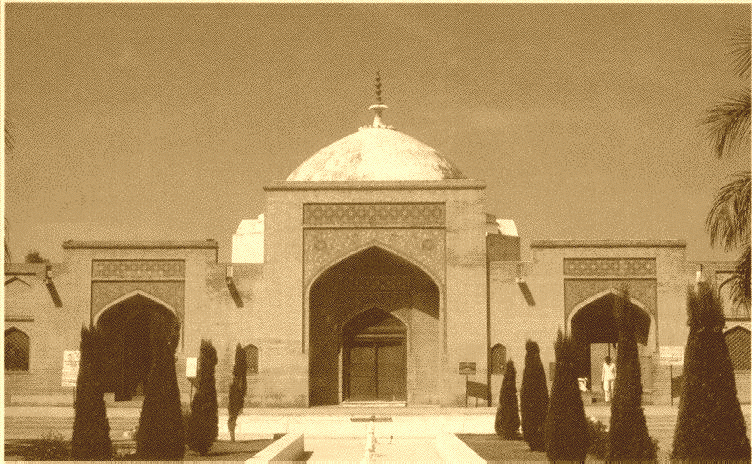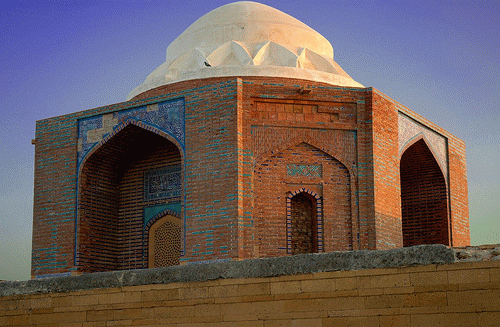The mosque was built under the patronage of the sixth Mughal Emperor, Aurangzeb Alamgir. It was completed in 1673 under the supervision of Aurangzeb's foster brother Muzaffar Hussain (also known as Fidaie Khan Koka) who was appointed governor of Lahore in May 1671 and held this post until 1675. He was also Master of Ordnance to the emperor.
The construction of the mosque took about two years, from May 1671 to April 1673. The mosque was built opposite the Lahore Fort, illustrating its stature in the Mughal Empire. In conjunction with the building of the mosque, a new gate was built at the fort, named Alamgiri Gate after the Emperor.
From 1852 onwards, piecemeal repairs were carried out under the supervision of the Badshahi Mosque Authority. Extensive repairs were carried out from 1939 to 1960 at a cost of about 4.8 million rupees, which brought the mosque to its original shape and condition. The blueprint for the repairs was prepared by the late architect Nawab Zen Yar Jang Bahadur.
In 2000, the repair work of marble inlay in the main vault was repaired under the supervision of Saleem Anjum Qureshi. On the occasion of the second Islamic Summit held at Lahore on February 22, 1974, thirty-nine heads of Muslim states offered their Friday prayers in the Badshahi Masjid, led by Maulana Abdul Qadir Azad, the 'Khatib' of the mosque.
Recently a small museum has also been added to the mosque complex, which contains relics of Muhammad, his cousin, and his daughter, Hazrat Fatima Zahra.
Thatta (Thatto in local language) is a historical and important city of the Sind Province of Pakistan. The city lies some 100 kilometers east of the Karachi metropolis on the National Highway. With River Indus and the Arabian Sea coast to its west, Thatta was once an important and thriving city and a centre of the then newly thriving religion of Islam. From the 14th century four Muslim dynasties ruled Sind from Thatta, but in 1739 the capital was moved elsewhere and with it Thatta declined. Thatta has a very rich heritage of Muslim architecture during the era of the 16th and 17th century. Although Thatta is known for its history which dates back to some 2000 years, it is also known for the Shah Jahan Mosque - a masterpiece of Mughal construction. This mosque was built by Mir Abdullah on the orders of Mogul emperor Shah Jahan in 1647 A.D. It is said that Shah Jahan built this mosque as a gesture of gratitude to the people of Thatta for sheltering him during his youth after his father, Emperor Jahangir banished him from Delhi.
Architecturally unique, Shah Jehan mosque is the first mosque in this region to be constructed according to the principals of Mughal courtyard architecture. As per some Persian inscriptions, the foundation of the mosque were laid in 1644 and mosque was completed in 1647. The floor was paved with stone in 1657.The mosque is a superb example of crafty tile work. Its 93 domes and 33 arches with varying sizes add to their architectural beauty. The domes have been exquisitely laid in a mosaic of radiating blue and white tiles. Its blue tiles and mosaic work are alluring. Red brick is utilized rather than the more commonly seen pink sandstone and marble associated with Mughal buildings.
The main entrance of the mosque has a central domed chamber. The mosque has an open central courtyard of about 15,900 square feet. Arcades of red brick arches highlighted with bands of white surround the courtyard. The main entrance is in the eastern portion and the secondary entrances are contained in the north and south portion. The prayer hall has three bays on either side of the central meh-rab chamber. Each bay is covered by a low dome, which adds up to 93 domes. The proportion of the aisle to the low domes enables an acoustic range that in effect allows the prayers read in front of the mihrab to be heard in all parts of the mosque. The mosque is spread over an area of 51,850 square feet.
Unlike other mosques, Shah Jahan Mosque has no minarets. Instead of the typical three domes, there is only one main dome in the prayer hall. The ablution pond is not located in the center of the courtyard. Instead, it is in a square courtyard located within the eastern portion of the mosque. The ablution courtyard could be access from an arched opening in the domed entrance chamber but now is accessible only from the aisle of the eastern portion. The mosque is combination of Turkish and local artwork, which is profusely used on tile work in the ceiling decoration of semi domed and domed chambers; as well as in the fillings of interlaced arches.
It would not be wrong to call this mosque as the mosque of domes and arches as one can see a series of lined arches while standing in any one corner. Each arch has a small atop with beautiful mosaic and tile work. In fact no Mogul period mosque is like the Shah Jahan mosque at Thatta, since the Mogul architects digressed from their typical architecture and designed this mosque totally different from those built in Lahore and Delhi in the same period. This is what makes this mosque unique from the rest and worth visiting - and admiring.




In the old days, people used to risk their lives in India or in the Americas in order to bring back products which now seem to us to have been of comically little worth, such as [brazilwood and pepper, which] added a new range of sense experience to a civilization which had never suspected its own insipidity. . .[From] these same lands our modern Marco Polos now bring back the moral spices of which our society feels an increasing need as it is conscious of sinking further into boredom, but that this time they take the form of photographs, books, and travelers tales. Cheap Flights to Lahore
ReplyDelete